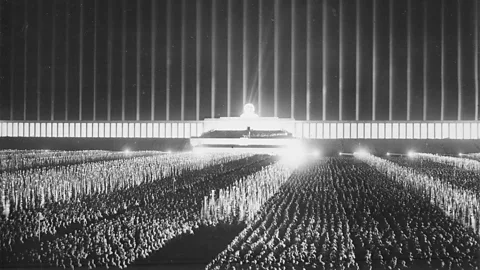Speer also claimed to be no different from anyone else in his generation who was seduced by the Nazi leader. “Hitler himself was appearing in a time which was to us young people a time of disillusionment. It was a time, we had no hope for our future, and now a man came and said you shall have hope, we can do it, we can manage it, Germany is prospering again. Of course it was a temptation big enough to think about.”
 Alamy
AlamyBut surely alarm bells should have rung? In 1934, during the Night of the Long Knives, the SS murdered around 400 of Hitler’s opponents. Speer was sent to repurpose the office of Vice-Chancellor Franz von Papen into security headquarters. In his memoir Inside the Third Reich, Speer recalled seeing a pool of dried blood where one of Papen’s aides had been shot. “I looked away and from then on avoided the room,” he wrote. He told Charlton: “It is a complete moral failure of mine not to have had any reactions, and it would be wrong to make now any excuses. In fact, I saw this bloodstain and I shoved it away in my memory. It was no more existent, and I was going on to work. If I would have only a little bit thought about it, I should have gone away from Hitler in this moment. But I didn’t.”
One of the most powerful men in the Third Reich
Speer would never get to fulfil his most ambitious architectural project: a complete rebuilding of Berlin, which was to be renamed Germania, future capital of the world. At its heart, Speer envisaged a vast north-south avenue, culminating in a Great Hall with a dome 16 times higher than St Peter’s in Rome. It’s thought that the interior would have been so vast that when filled with the breath of 180,000 gathered Nazis, rainclouds may have formed in the ceiling. Instead, in 1939 Hitler started World War Two, and plunged Europe into six years of hell.
In 1942, he made Speer minister for arms production, drawing upon his extraordinary organisational skills to meet the demands of total war. At the age of 37, the architect was now one of the most powerful men in the Third Reich. To keep feeding the Nazi war machine with firepower, Speer used slave labour in his factories, mines and quarries. More than seven million forced labourers were employed by German industry, heavily concentrated in the armament sector overseen by Speer. Some were worked to death in terrible conditions. Historian Hugh Trevor-Roper told the 1996 BBC Reputations documentary, The Nazi Who Said Sorry, that Speer knew what he was doing. “He had formidable methods of control and could use the concentration camp system if he wanted, but he got the work done, and that impressed Hitler,” he said.


